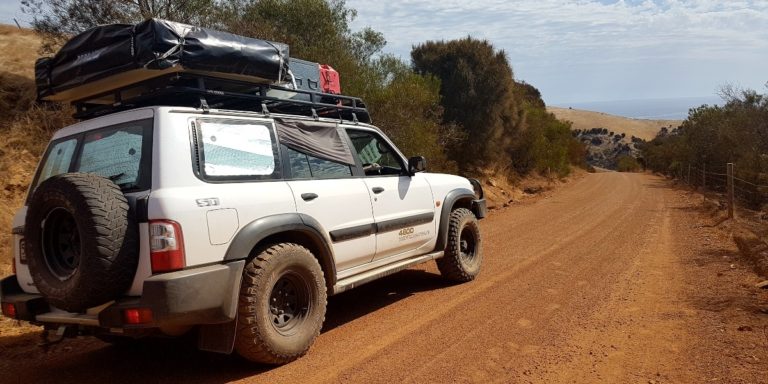
Quieter and wilder than the East Coast, the West Coast of Australia is a paradise for nature lovers, with gorgeous landscapes, sprawling desert plains and heavenly beaches! The West Coast of Australia is one of the most popular routes on the continent for a road trip, with more than 4000 kilometres of landscapes as wild as they are varied. From Margaret River in the South to Broome in the North, discover all the best stops and spots not to be missed for an unforgettable trip.
Table of Contents
How Long Do You Need for a West Coast Road Trip?
🚐 Trip Duration
To travel the West Coast by campervan, 4WD or motorhome, plan for at least three weeks—though four weeks is ideal, allowing for a more relaxed pace. If you want to make the most of it and take your time, allow at least 6 weeks.
📍 Distances & Planning
Be prepared to cover nearly 4,500 km from Perth to Darwin (or vice versa). The West Coast is less densely populated than the rest of Australia and cities can be separated by long distances. Always carry extra food, water, and fuel to avoid getting stranded in remote areas. Checking road conditions and weather updates is essential, especially if you’re venturing into off-road tracks.
Best Time to Travel the West Coast
Australia’s West Coast is vast, stretching over thousands of kilometers, which means the climate varies significantly from north to south. Understanding these differences will help you plan the best time for your epic road trip!
🌴 Perth & the South
Perth enjoys a Mediterranean climate, making it one of the sunniest cities in Australia!
- Summer (Dec – Feb): Expect hot temperatures averaging 29°C, but they can soar to 40-45°C in February.
- Winter (Jun – Aug): Mild and cooler, with temperatures around 12°C and occasional rain.
🐠 Coral Coast (Perth to Broome)
This region enjoys warm temperatures year-round—perfect for exploring its turquoise waters and coral reefs.
🌞 The North-West (Broome & Beyond)
- Dry Season (Apr – Sep): Sunny skies, warm days around 29°C, and cooler nights—the best time for a road trip!
- Wet Season (Oct – Mar): Expect tropical rainstorms, high humidity, and temperatures around 30°C. Cyclones are also possible in some areas, so check the weather forecast before traveling.
THE BEST TIMES TO VISIT THE WEST COAST ARE MID-SEASON, BETWEEN MARCH AND MAY, OR BETWEEN SEPTEMBER AND NOVEMBER.
Climate in Darwin
| Jan. | Feb. | Mar. | Apr. | May | June | |
| 🌡️ Min (°C) | 25 | 25 | 25 | 24 | 22 | 20 |
| 🌡️ Max (°C) | 32 | 31 | 32 | 33 | 32 | 30 |
| 🌧️ Days of rain | 21 | 20 | 20 | 9 | 2 | 1 |
| July | Aug. | Sept. | Oct. | Nov. | Dec. | |
| 🌡️ Min (°C) | 19 | 20 | 20 | 23 | 25 | 25 |
| 🌡️ Max (°C) | 30 | 31 | 31 | 33 | 33 | 33 |
| 🌧️ Days of rain | 1 | 1 | 2 | 7 | 12 | 17 |
Climate in Perth
| Jan. | Feb. | Mar. | Apr. | May | June | |
| 🌡️ Min (°C) | 17 | 17 | 20 | 13 | 10 | 9 |
| 🌡️ Max (°C) | 32 | 32 | 28 | 26 | 22 | 19 |
| 🌧️ Days of rain | 2 | 1 | 2 | 4 | 9 | 12 |
| July | Aug. | Sept. | Oct. | Nov. | Dec. | |
| 🌡️ Min (°C) | 8 | 8 | 9 | 10 | 13 | 15 |
| 🌡️ Max (°C) | 18 | 18 | 20 | 23 | 26 | 29 |
| 🌧️ Days of rain | 14 | 13 | 8 | 5 | 4 | 2 |
West Coast Road Trip Budget
To have a successful trip, you’ll need to budget carefully. Make sure you have enough money (both in your bank account and in cash) to avoid awkward situations. For your information, here is our estimated budget for a 1-month van road trip (rental) for 2 people:
- 2-seater van rental, including insurance: $3,000 (depending on season)
- Fuel: $1000 (average rate of $1.90/L and a consumption of 10L/100km)
- Food: $500 (for no-frills food)
- Campsite fees: $300 (1 night/5 or 6 nights at the rate of $50/night)
- Excursions and activities: $1000
- Restaurants and outings: $470
Total: $6250 for 2 people.
Road Trip Budget Calculator
Calculate your road trip budget according to your needs. Free and easy!
Where to Stay on the West Coast?
Unlike the famous (and touristy) East Coast, the West Coast is very wild, which means camping most of the time. You will find motels or roadhouses offering accommodation along the coast. However, the distances between these accommodations can be long, so plan where you will be sleeping in advance if you don’t want to find yourself having to camp in the middle of nowhere!
For those who plan to camp, you will easily find places to sleep on the coast. Some of them charge fees (caravan parks and rest areas) and others are free (camping spots or free camps). Wild camping, i.e. camping outside of designated areas, is generally not permitted and if you’re caught you could be landed with a big fine. However, you will see once you’re on the coast that there is no shortage of space and ranger checks are rare. Avoid wild camping in popular tourist areas.
📲 Must-Have Camping Apps & Resources
To find free and paid campsites, these tools are lifesavers:
✅ Camp Australia Wide (Book) – Lists over 1,000+ camping areas.
✅ WikiCamps App ($8) – Interactive map with toilets, showers, fees, and POIs.
✅ CamperMate (Free) – A solid alternative to find campsites & facilities.
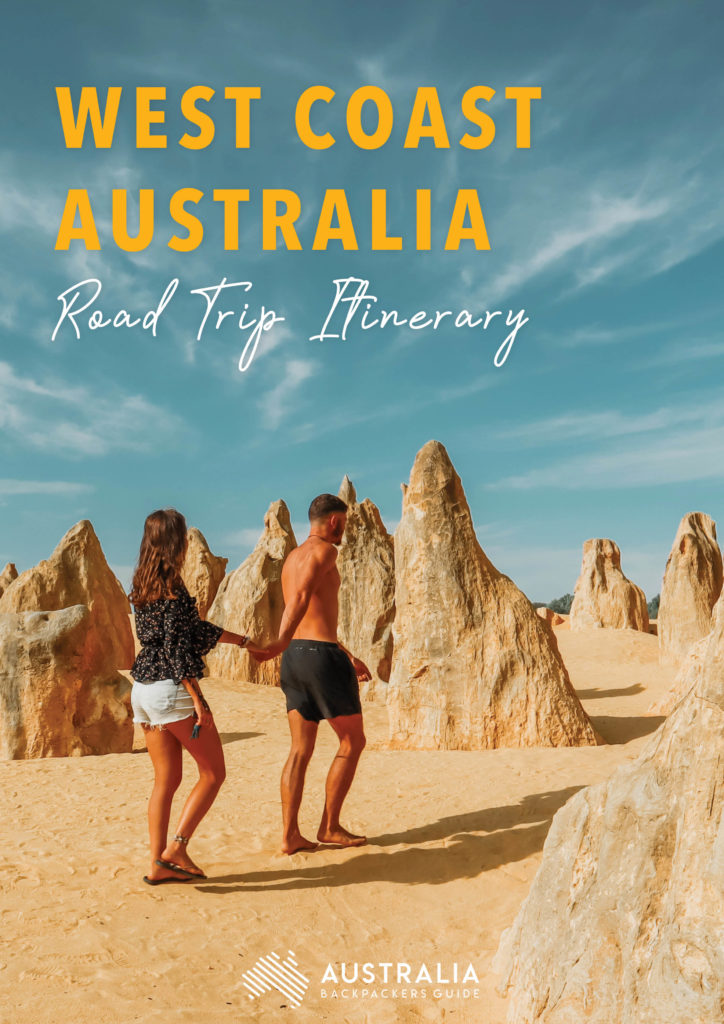
Download our Complete Guide to your West Coast Road Trip
- Prepare for your trip (best time to go, budget)
- All the best spots to hit along the coast
- Tours and activity recommendations
- Spots to park and sleep in a campervan
How to Travel Along the West Coast?
The West Coast of Australia is a dream destination for a road trip, but choosing the right vehicle is crucial! The terrain varies from smooth highways to rugged off-road tracks, so your travel style and itinerary will determine the best option.
Choosing the Right Vehicle
First, choose your type of vehicle according to your needs:
- Motorhome with all the comforts and amenities
- Campervan – A more budget-friendly option, smaller but still great for road-tripping.
- 4WD (Four-Wheel Drive) – Highly recommended! 🚨 If you want to explore national parks, remote beaches, and off-the-grid locations, a 4WD is a must. It allows you to:
- Access off-road tracks (like the famous Gibb River Road in the Kimberleys).
- Drive on beaches, gravel roads, and through rivers.
- Stay at campsites only accessible by 4WD.
- Station wagon: you can save on travel this way.
2WD or 4WD?
If you plan to stick to main roads and tourist spots, a 2WD is fine. However, if you want to fully experience the wild West Coast and reach hidden gems, a 4WD is the way to go!
Campervan Rental
You can rent a campervan or motorhome in Perth or Darwin (NT). It is also possible to pick up or drop off a vehicle in Broome, although you will have fewer options to choose from.
Main Rental Companies
- Britz
- Apollo Campervans
- Travellers Autobarn (5% discount available here: Travellers Autobarn Promo Code)
To compare campervan and motorhome rental prices, visit the price comparison website Motorhome Republic
Car Rental
Another popular option is car rental. You will find many different agencies across Australia, including Britz and Travelers Autobarn. Remember to plan ahead to nab your ideal vehicle because rentals go quickly, especially in high season. You will find many car rental agencies around Perth airport or in Darwin.
To compare car rentals in Australia: CLICK HERE
Buying a Vehicle
If you’re planning to go on a road trip as soon as you arrive in Australia, a great option is to go through backpackercars.com. They offer all types of vehicles for sale (cars, vans, and 4WDs) and can customize them according to your needs. The advantage is that all the mechanics are checked, the paperwork is in order, and you can pick up your vehicle as soon as you arrive in Australia.
📍 Vehicles available in Sydney, Melbourne, and Perth
📝 Avoid all the paperwork
👨🔧 Avoid mechanical surprises with a reliable vehicle
🚗 Pick up your vehicle as soon as you arrive in Australia
🚨 BONUS: 1 year of free roadside assistance with our PROMO CODE: BACKPACKERS
Public Transport
There are no trains or buses that run along the entire west coast. However, you can join a group of travellers by bus. This is an option if you don’t have your driving licence or don’t want to travel alone. You will have less freedom in your route, but that also means less things to worry about, like driving, refuellng, changing wheels in the event of a puncture, etc.
Bus companies:
- Integrity Coach Lines: “hop on/ hop off” system between Perth and Broome.
- Greyhound: only between Broome and Darwin.
- Why Not Bus: group trip with tours to the emblematic places between Perth and Broome (Pinnacles, Karijini National Park, Exmouth, etc.).
- The Magic bus: a group of 25 backpackers (from Perth to Broome, from March to November only).
Carpool or Lift
You can find fellow travellers looking for people to join them on the road to split travel costs. This can be a good option if you want to meet new friends and save money. There are many ads on Facebook and Gumtree. Make sure you meet your road trip buddies before you leave, to make sure you get along and are on the same page.
Highlights of the Perth – Darwin Route
- Karijini National Park: Exploration of its spectacular gorges, natural pools, and hiking trails.
- Broome and Cable Beach: Relaxing on the pristine beaches and observing dinosaur footprints at Gantheaume Point.
- Kakadu National Park: Discovering the rich biodiversity, Aboriginal rock paintings, and crocodiles in their natural habitat.
- The Kimberleys: Adventure in this wild region, visiting the Bungle Bungle Range and isolated waterfalls.
But we’ll tell you more about it below…
🔗 Looking for the best way to explore Western Australia? Check out this guide to compare van rentals in Australia to start your adventure!
Perth to Darwin Road trip Itinerary
Perth and its Surroundings (5 to 6 days)
The Capital of WA, Perth
Nestled along the banks of the Swan River, Perth is a modern, cosmopolitan city and the most isolated capital in the world. Despite its remoteness, Perth is dynamic and constantly evolving, offering a mix of urban charm and breathtaking nature.
Must-Visit Spots in Perth
- Kings Park & Botanic Garden – Covering over 400 hectares, this stunning park is larger than New York’s Central Park! Walk among wildflowers, native plants, and elevated walkways. Feeling adventurous? Climb the 101 steps for panoramic views of the city and river.
- Elizabeth Quay – A lively waterfront precinct, perfect for relaxed strolls, dining, or enjoying a drink while watching the sunset over the Swan River.
- Perth Cultural Centre (Northbridge) – Home to:
- 🎨 Art Gallery of WA (Free, open 10 AM – 5 PM) – Showcasing Australian and Aboriginal art.
- 🏛️ WA Museum Boola Bardip (Free, open 9:30 AM – 5 PM) – Featuring meteorites, a 25m whale skeleton, and the historic Old Jail from 1856.
- Perth Zoo – Open daily, this zoo is dedicated to wildlife conservation and houses 160+ species, including iconic Australian animals like kangaroos, wombats, and koalas.
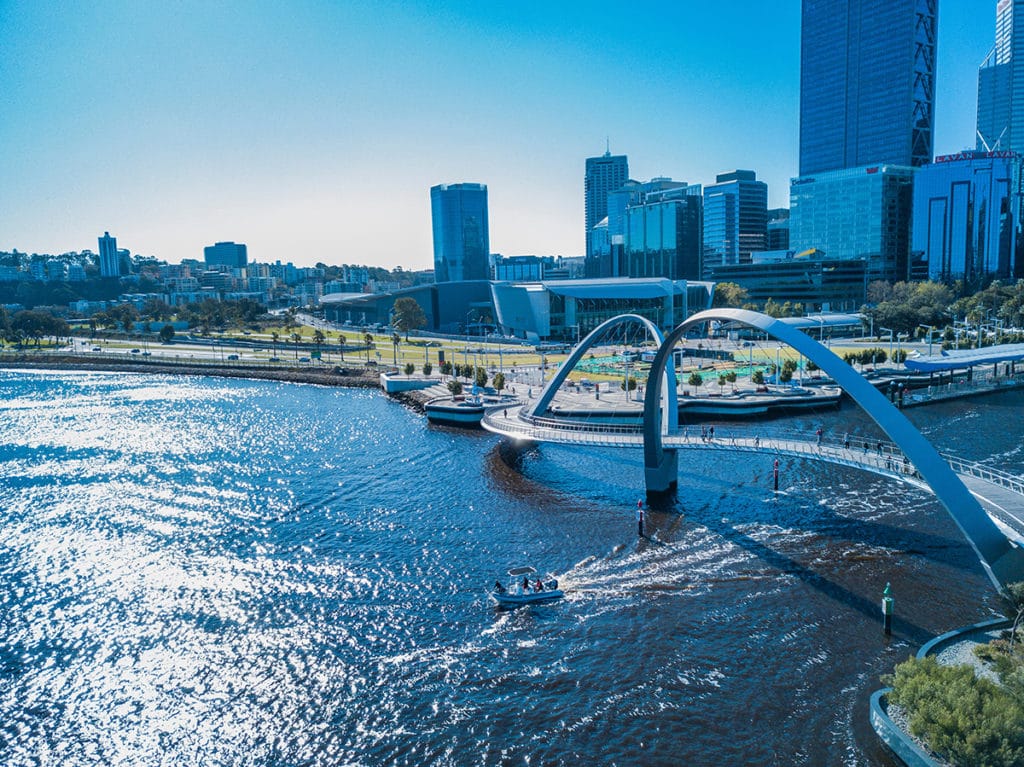
Fremantle
Fremantle is a small town of 25,000 people located 19 kilometres southwest of Perth. “Freo” stands out for its history, closely linked to that of 18th-century convicts. Today, Fremantle’s main tourist attraction is its numerous street markets. Taste its many dishes across more than 150 stands: fruits, vegetables, confectionery, international food, crafts, etc …
Rottnest Island
Just 19km off the coast of Perth, Rottnest Island is a must-visit destination for nature lovers and adventure seekers. This protected nature reserve boasts stunning beaches, crystal-clear waters, and car-free roads, making it perfect for exploring by bike or on foot.
🦘 Meet the Quokkas! Rottnest is famously home to the quokka, often called the happiest animal on Earth! These friendly marsupials are not shy around humans, so if you’re lucky, you might snap the ultimate quokka selfie.
You can take many different day trips here (an adventure boat, for example) or guided tours that last just a few hours, like a Segway tour. There are also activities like parachute jumping, whale watching, etc.
🚢 How to Get There?
The only way to reach Rottnest is by ferry from Perth or Fremantle. For the best experience, we recommend booking a ferry + bike rental package, allowing you to make the most of your day on the island.
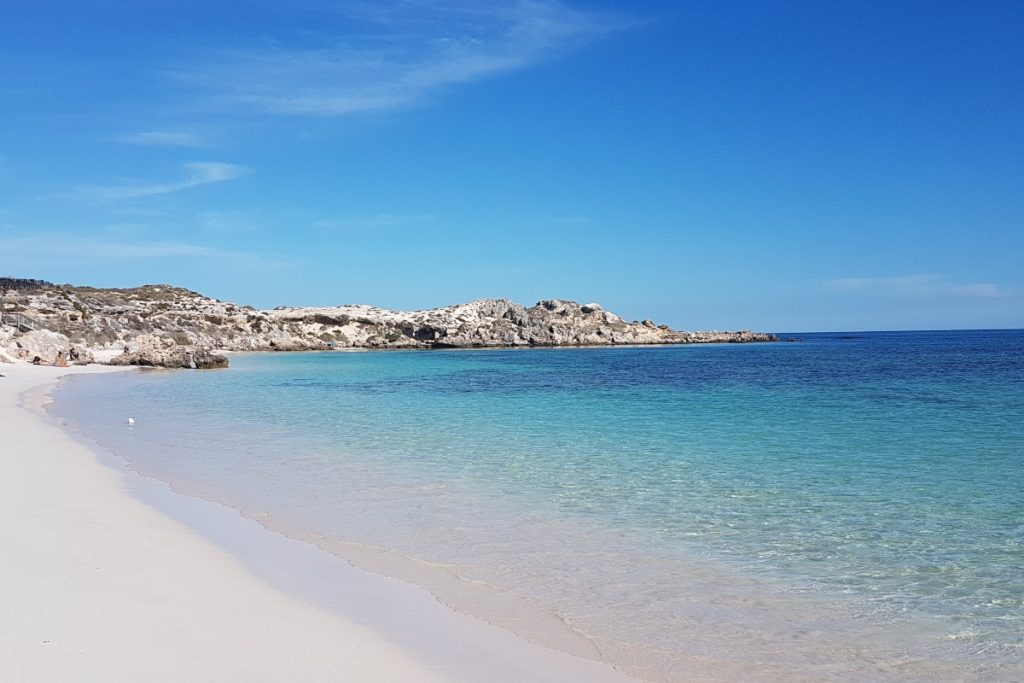
Margaret River
Just three hours south of Perth, Margaret River is a stunning region where pristine beaches, rolling vineyards, and ancient forests come together to create the perfect getaway. Whether you’re a wine enthusiast, surf lover, or nature explorer, there’s something for everyone in this scenic paradise.
🌊 Surf, Sip & Explore
- World-Class Surfing – Margaret River is a top global surf destination, with powerful waves at Surfers Point.
- Wine & Gourmet Delights – Over 100 vineyards produce some of Australia’s best Cabernet Sauvignon & Chardonnay.
- Scenic Coastline – White sand beaches, rugged cliffs, and turquoise waters make it perfect for swimming, snorkeling, and coastal hikes.
- Unique Rock Formations & Caves – Explore Lake Cave, Jewel Cave, and Mammoth Cave for an underground adventure.
Road Trip Highlights Between Perth & Margaret River
📍 Eagle Bay – A hidden gem with crystal-clear waters and stunning coastal views.
📍 Busselton Jetty – The longest timber jetty in the Southern Hemisphere—perfect for a seaside stroll.
📍 Bunbury Dolphin Discovery Centre – Swim with wild dolphins for an unforgettable experience!
Perth to Geraldton (2 days)
Three hours from Perth, head north on Indian Ocean Drive to reach Nambung National Park. This park is famous for its rock formations (the Pinnacles) that look like stalactites. It is possible to get there on foot or (when weather conditions allow) to follow a track with your own vehicle right in the middle of these strange totems. At the exit of the Pinnacles, you can visit the village of Cervantes, renowned for its fishing and its white sand beaches. On your way to Geraldton, stop at the famous and popular beaches of Jurien Bay. Surfers and windsurfers will also want to take the opportunity to stop in Geraldton for a dip.
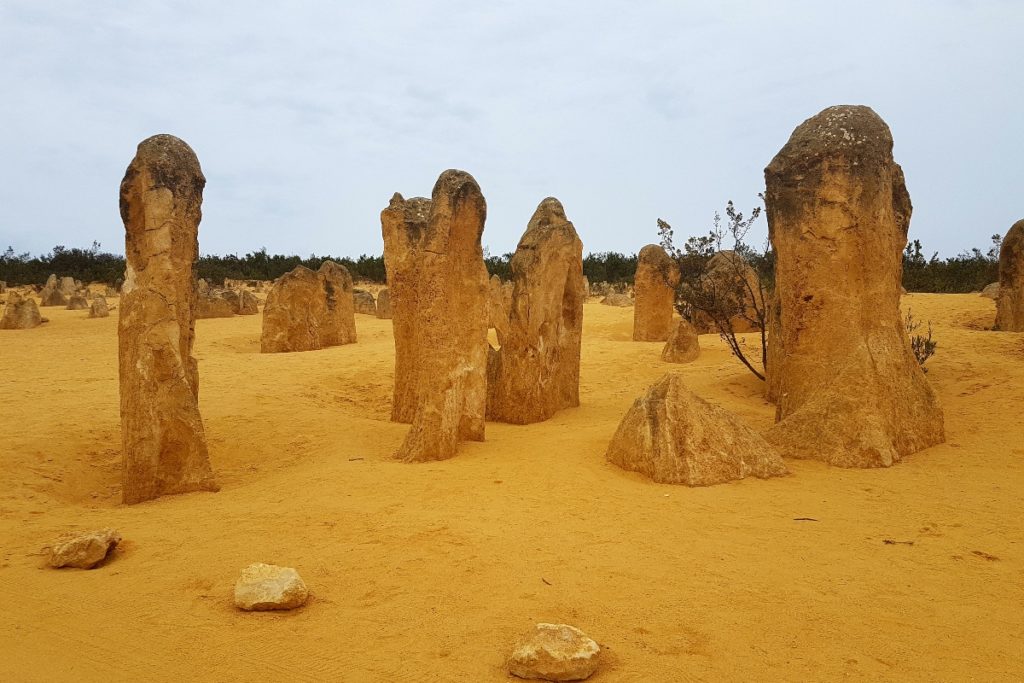
Geraldton to Carnarvon (4 days)
This stretch of Western Australia’s Coral Coast offers some of the most surreal landscapes, from bubblegum-pink lakes to dramatic red cliffs and stunning national parks.
🌸 Hutt Lagoon – Port Gregory (100 km from Geraldton)
- One of the two pink lakes in Australia, thanks to Dunaliella Salina algae, which produces a deep pink hue.
- Best seen midday or at sunset for the most vibrant colors.
- Easily accessible from Port Gregory, just a short detour from the main highway.
🌄 Kalbarri National Park – Cliffs & Canyons
- Drive along the Indian Ocean Drive to admire Red Bluff, Mushroom Rock, and Natural Bridge.
- Explore Nature’s Window, a stunning rock formation framing the dramatic Kalbarri Gorge. 📸
- Adventure seekers can go hiking, abseiling, kayaking, or take a scenic flight over the park.
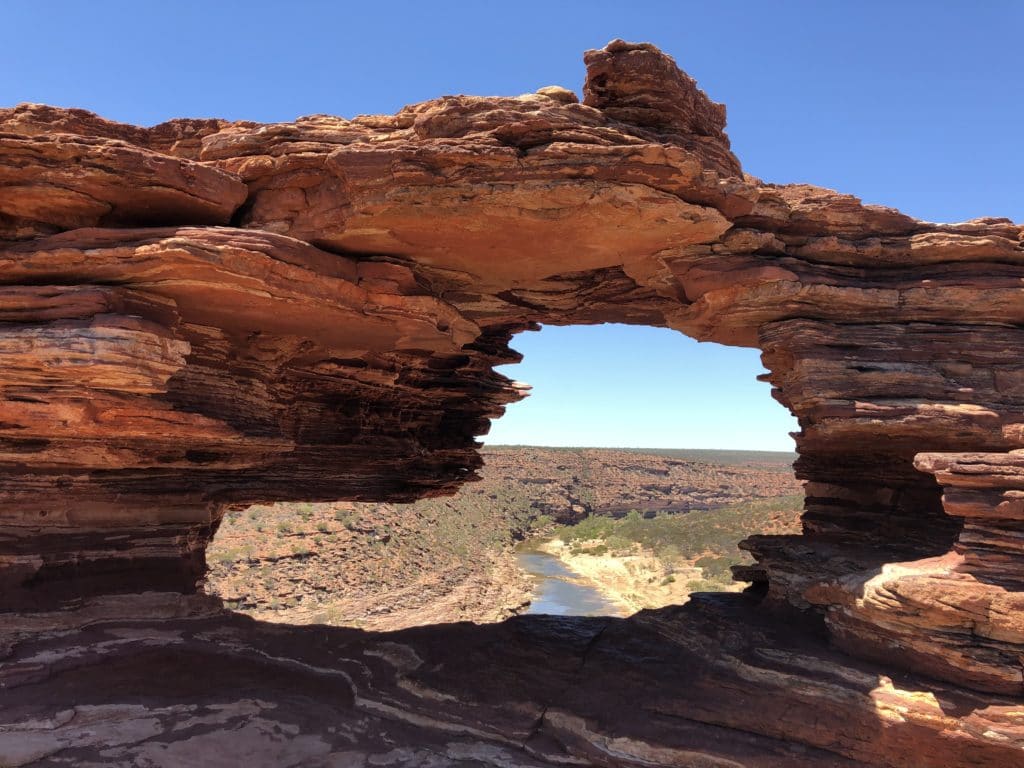
Further north, Shark Bay National Park on the West Coast is one of the biggest marine sanctuaries in the world. Famous for the town of Monkey Mia, you can approach the dolphins 🐬 playing in the water and maybe even feed them some fish! Shark Bay is also home to a variety of marine wildlife: whales, manta rays, sea turtles, sharks and dugongs. Known for its extraordinary ecosystem, you will be fascinated by the François Perron National Park, where you will find one of the only sites in the world where you can observe marine stromatolites. These exceptional geological formations, resembling small domes, were built by microbes more than 350,000 years ago. A little further, Shell Bech beach is one of the few beaches made up entirely of shells!

Carnarvon to Exmouth (3 to 4 days)
This stretch of the West Coast takes you from Carnarvon’s farmlands to the breathtaking Ningaloo Reef, home to some of Australia’s most stunning marine life. Carnarvon is a coastal town and the last major town before you get to Karratha. Blessed with a subtropical climate, the temperature is pleasant all year round. Known for its banana plantations, mangoes, and fresh produce 🍌🥭 (backpackers often find farm work here, but competition is high). When there, visit Lake Macleod, a unique partially dry lake, before heading north.
Going up towards the North West point via the Minilya-Exmouth Road, you will arrive at the Ningaloo Marine Park. Coral Bay will be your starting point 🐠 – a laid-back beach town, popular with locals and travelers alike. Perfect for snorkeling and diving – the reef starts just a few meters from the shore! There, you can swim with whale sharks (March to July) or manta rays (year-round)
Continue on to the town of Exmouth to set off on an excursion to the famous Cape Range National Park, home to deep gorges and rugged canyons. Visit Oyster Stacks and Turquoise Bay – some of the best snorkeling spots on the Ningaloo Reef. Allow at least one full day to hike, swim, and take in the incredible landscapes.
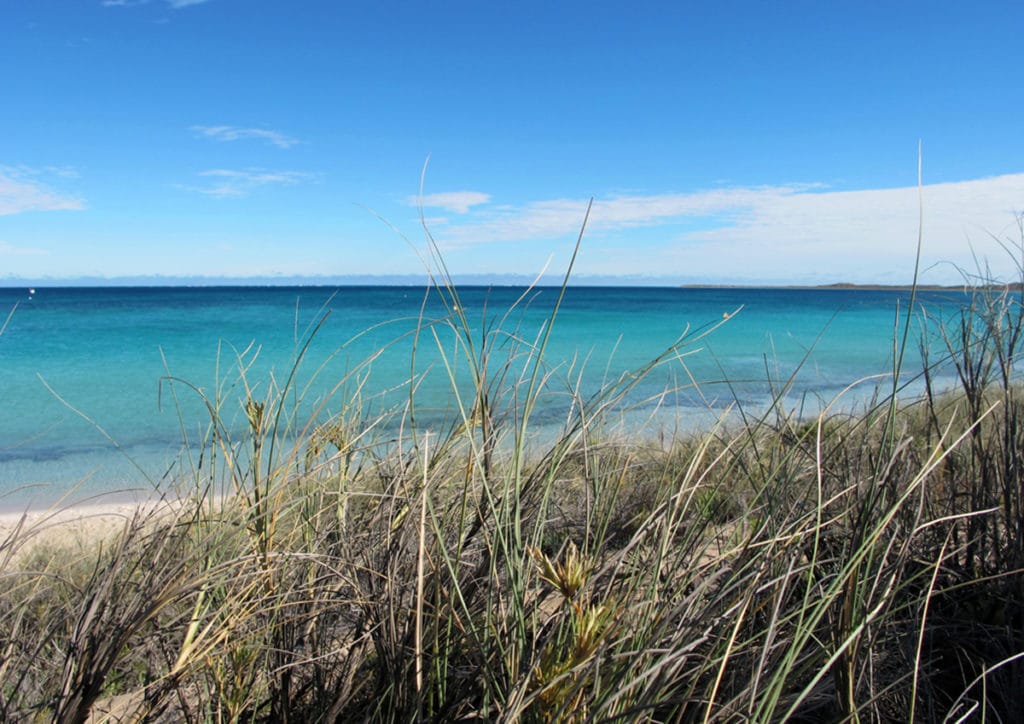
Exmouth to Karratha (1 to 2 days)
Cross the desert for 550 kilometres between Exmouth and Karratha. We advise you to stop at each roadhouse to refuel and enjoy a short break. There is not really much to see in this part of the coast.
Karratha to Broome (2 to 3 days)
Karratha is the industrial hub of the Northwest. It is the largest town in the Pilbara, known for its mining and industrial sector. It serves as a gateway to some of Western Australia’s most stunning natural landscapes. Stop here to stock up on fuel, food, and supplies before heading inland.
A few kilometers after Karratha, more inland, you’ll find the jewel of the Pilbara: Karijini National Park. One of Australia’s most spectacular national parks, covering 6,274 km²! Famous for its deep gorges, waterfalls, and natural swimming pools. 💦 It is also a unique spot to observe wildlife, including kangaroos, echidnas, geckos, goannas, and even snakes 🦎🦘.
✅ Top hikes & must-see spots:
- Fortescue Falls – A stunning year-round waterfall 🌊
- Fern Pool – A natural swimming spot with crystal-clear water 🏊
- Hancock Gorge & Weano Gorge – Thrilling hikes through towering red rock canyons
🛑 Essential Tip: Be well-prepared with ample water, food, and a 4WD – the terrain can be rugged and remote.

Tom Price, the nearest town, is 80 kilometres from the park, in the heart of the huge Marandoo iron mine. The road between Karratha and Broome is mostly desert. Port Hedland is a port city on the Australian North Coast. Its deep water makes it the main port in the region for receiving oil and containers. Its climate is harsh, with very high temperatures throughout the year and little rainfall. Port Hedland is not really a tourist town. There is only one beach, but be very careful of the crocodiles!
Broome (1 to 2 days)
Broome is where the red desert meets the turquoise waters of the Indian Ocean, offering a unique mix of outback adventure and tropical paradise. This vibrant coastal town deserves a few days’ stopover before heading deeper into the Kimberley region.
🌊 Top Things to Do in Broome
- Ride a Camel at Sunset 🐪 – Experience a breathtaking sunset on Cable Beach while riding a camel along the 22 km stretch of white sand.
- Discover the Pearl Industry – Broome has a rich pearling history. Visit a local pearl farm or browse luxury pearl shops in town to see some of the world’s finest pearls.
- See Dinosaur Footprints – Head to Gantheaume Point during low tide to spot 125-million-year-old dinosaur footprints embedded in the rock.
- Experience Staircase to the Moon – From March to October, witness this magical natural phenomenon as the full moon rises over the tidal flats of Roebuck Bay, creating an illusion of a staircase leading to the moon.
- Explore Local Markets – Visit the Broome Courthouse Market (Saturday & Sunday mornings) or the full moon night market (April to October) for handmade crafts, fresh produce, and delicious street food.

From Broome to Darwin (5 to 15 days)
The journey from Broome to Darwin takes you through some of Australia’s most remote and breathtaking landscapes. Whether you stick to the main highway or take the iconic Gibb River Road, there’s no shortage of incredible sights along the way.
🌿 Must-See Stops Along the Way
- Derby & The Giant Boab Prison Tree 🌳 – Make a quick stop in Derby to see the massive boab trees, some of which were historically used as holding cells for Aboriginal prisoners.
- Gibb River Road (4WD Only) 🚙 – If you’re driving a 4WD, don’t miss the legendary 659km Gibb River Road, where you’ll navigate rivers, remote desert landscapes, and rugged terrain to discover stunning gorges like:
- Windjana Gorge & Tunnel Creek – Famous for its ancient caves and fresh-water crocodiles.
- Bell Gorge – One of the most beautiful waterfalls in the Kimberley.
- El Questro Wilderness Park 🌿 – Even if you don’t have a 4WD, you can still explore El Questro Station, home to stunning hot springs and waterfalls.
- Kununurra & Lake Argyle 🚤 – A perfect base for exploring the Kimberleys, including Lake Argyle, Australia’s second-largest man-made lake, where you can enjoy boat cruises and spot freshwater crocs.
- Katherine Gorge (Nitmiluk National Park) 🐊 – Take a boat cruise through dramatic sandstone gorges, home to saltwater crocodiles and breathtaking waterfalls.
- Litchfield National Park 🌿 – Before reaching Darwin, spend a few days at Litchfield NP, known for its stunning waterfalls, crystal-clear swimming holes, and giant termite mounds.
After crossing the Northern Territory border, you’ll arrive in Darwin, the tropical capital famous for its markets, Aboriginal culture, and access to Kakadu & Litchfield National Parks.

West Coast Tours and Activities
West Coast Tours and Excursions
With its wild and varied landscapes, its magnificent beaches and its huge national parks, the West Coast is full of activities that you can indulge in during your road trip. Parachute jumping, snorkeling, scuba diving, scenic flights, 4WD tour, etc. There is something for everyone!
Purnululu National Park (Bungle Bungle)
The Bungle Bungle Range is a fantastic natural formation made of beehive-shaped sandstone domes. It is one of Australia’s few World Heritage Sites. There are many ways to discover this unusual place, by hiking or from the air. There are plenty of beautiful walks (Cathedral Gorge, Doms Walk, Mini Palms Gorge, Echnida Chasm) as well as charming local art sites and abundant fauna and flora.
Margaret River
The Margaret River region developed over 60,000 years ago. It is an important place in Aboriginal culture, since it is the traditional land of the Wadandi people (salt water). Take the time to visit the city and its surroundings to fully immerse yourself in the climate that reigns here. The best excursion you can take to Margaret River is a day trip from Perth. During this trip, you will visit Busselton Jetty and the lighthouse of Cape Leeuwin, as well as Mammoth Cave.
Ningaloo Reef, the little Barrier Reef
This incredible reef, classified as a UNESCO World Heritage site, is absolutely worth a detour during your West Coast road trip! Its multicoloured corals, crystal clear waters and exceptional marine life combine to create an underwater paradise. Here you’ll discover colourful tropical fish, dugongs, reef sharks, humpback whales, whale sharks, sea turtles, manta rays, and more. You will be amazed by the much richness and beauty around you! We recommend the following activities:
- Swim with whale sharks (from 500AUD for 8h to 9h excursion with meal included).
- Humpback whale watching excursion (from 100AUD for 3 hour cruise with small snack).
- Swimming with manta rays (from 300AUD for 5/6h eco tour safari).
The above are really must-sees in the region and definitely worth the money! You’ll come home with memories to last a lifetime.
The Kimberleys
Extending over an area of more than 423,000 km2, the Kimberleys offer some of the most beautiful landscapes in Western Australia. Here you will discover spectacular gorges and cliffs as well as majestic waterfalls and some of the most beautiful beaches in the world, with their coral reefs and tropical islands. Explore the many hidden caves and Aboriginal rock art. The main bucket list activity here is a scenic cruise over the reefs of Swans Bay Waterfall, a 2-hour sea safari during which you can observe the natural phenomenon of the tides.
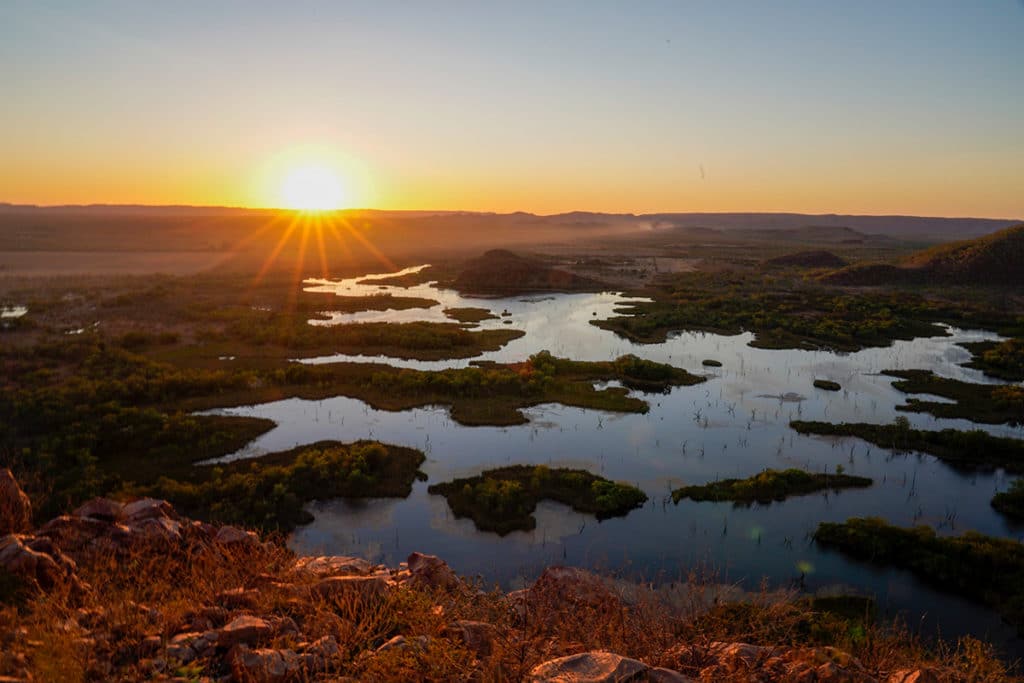
Wildlife and Flora
As you travel through Western Australia and the Northern Territory, keep an eye out for the incredible wildlife that calls this region home.
Spot Australian Icons 🦘🐦
- Kangaroos & Wallabies – Often seen at dawn and dusk, hopping across the roads or grazing in open fields.
- Emus – These flightless birds roam freely, especially in the Outback.
- Exotic Birds – From colorful parrots to majestic wedge-tailed eagles, bird lovers will be in paradise.
Discover Unique Ecosystems 🌿🌳
- Baobab Trees in the Kimberley – Also called “boab trees,” these ancient giants are iconic to Northern Australia.
- Lush Rainforests in the NT – As you approach Katherine & Darwin, the landscape transforms into verdant tropical forests.
🔍 Tip: National parks and nature reserves offer the best chance to see wildlife in their natural habitat—plan your stops accordingly!
Safety tips & Tricks
Safety
Safety should never be overlooked. It is vital to plan your route in advance, inform someone of your plans, and regularly check weather and road conditions. Moreover, store enough food, water, and fuel for several days, in case you are delayed or need to take an unexpected detour.
⚠️ Never drive at night. The lack of light makes roads dangerous, and wildlife is very much present and can appear out of nowhere at any time. Vehicle rental companies even prohibit night driving for these reasons.
Useful Tips
Protect your skin as much as possible during this road trip. The sun is very strong in Australia, it is not for nothing that it is the country with the highest rate of skin cancer in the world.
Bug spray will also be very useful during this trip, especially after dark.
🌅 Get up early – it’s the key to a successful road trip. In Australia, it can get unbearably hot in the afternoon.
On the road, remember to refuel regularly or to have reserves of gas because the distances are long. Also fill up with water as often as possible!
Download the complete West Coast Guide

Our FREE 40-page guide brings together all the info you need for your West Coast Road Trip in Australia:
- Prepare your trip (seasons, budget)
- All the best spots to do on the Coast
- Tours & activities recommendations
- Spots to park and sleep in a campervan
Updated on 25/02/2025





















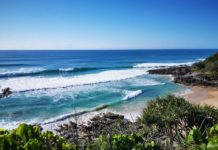
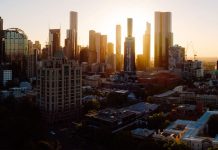





Last year I visited Western Australia and love it. Definitely, recommend everyone to visit Peth and Margaret River region – with all those gorgeous beaches, ahh. For everyone searching for a campsite, I would recommend CamperMate app as its free, plus you can even download a database of camps to your phone to not use internet on the go. For more camping tips in Western Australia check our blog. 😉